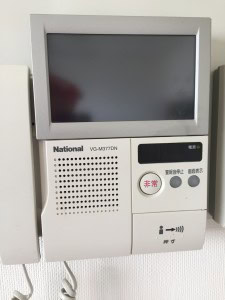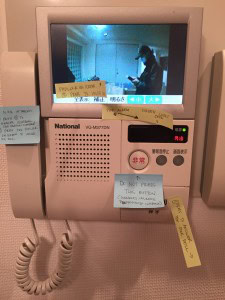Mistake-proofing and visual systems
Before this move, I had a preconceived notion that mistake-proofing (poka-yoke) and obvious visual controls would be commonplace in Japan. However, my first day in Japan proved that this is not the case.
Poka-yoke in Japanese means “mistake-proof”. In a Lean process it is any mechanism that helps an operator avoid mistakes. Visual controls are fundamental and make it easy to “see at a glance” how a process should or is performing.
How does the intercom work?
 Here is the photo of the intercom system in our new apartment. Without being able to read Japanese, it is not easily clear which sequence of steps must be taken or which buttons should be pressed in order to let someone in the front door.
Here is the photo of the intercom system in our new apartment. Without being able to read Japanese, it is not easily clear which sequence of steps must be taken or which buttons should be pressed in order to let someone in the front door.
Is it clear to you from this picture of what to do?
Thirty minutes into my arrival at our new apartment (less than 15 hours after arriving to Japan), the internet company’s installation representative rang our doorbell. Not knowing which steps to take, I operated with assumptions from prior experience and picked up the phone. This was correct, but the next steps were failures.
Hint – don’t push the red button!
I pressed a few buttons in attempt to open the downstairs door, including the large red button.
While it is the most obvious button – especially if you cannot read Japanese – the large red button is actually for emergencies. I suppose it is good that the one button you  might touch in case of emergency is likely to be the big red one, but it’s not so good if you are just trying to let someone inside.
might touch in case of emergency is likely to be the big red one, but it’s not so good if you are just trying to let someone inside.
The button sets off a loud alarm throughout the building and can only be turned off by a visit from the security company that monitors the complex. Thankfully our relocation support person was on-site and was able to help translate when the security guard arrived 15 minutes later. She performed a kaizen on our process by making some notes on post-its about the process steps so that we know what to do in the future (see photo).
The intercom process is definitely not obvious or visual. But it’s good to know what button to press now if we ever have an emergency!
Update: January 31
Despite the post-it notes on the intercom, our process still wasn’t mistake proofed. My husband pressed the red button and set off the same series of events, this time resulting in a challenging – but very polite and friendly – attempt at communication between the security guard and us when he arrived. We have now made another kaizen improvement towards mistake-proofing our intercom by adding red tape and writing “emergency” across it. I hope this improvement works and we have thwarted operator error moving forward!












